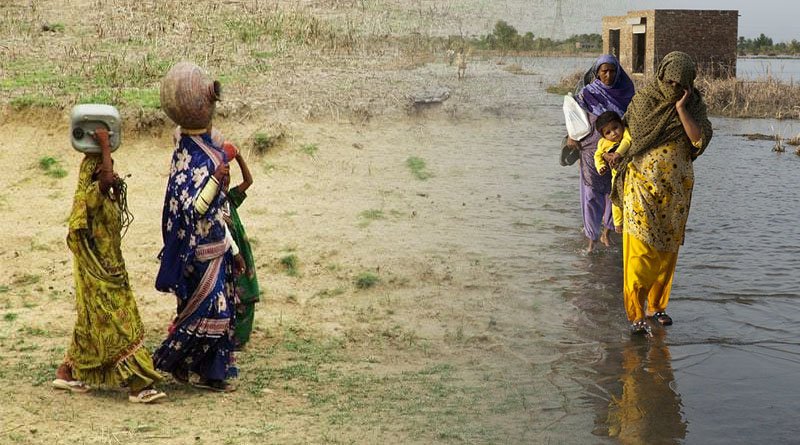Rising temperatures, sea-level rise, and extreme weather events are just a few examples of the adverse impacts of climate change on urban centers.

Climate change (CC) is a global challenge that affects all regions of the world. One of the most significant impacts of climate change is on urban centers, where the majority of the world’s population lives. Rising temperatures, sea level rise, and extreme weather events are just a few examples of the adverse impacts of climate change on urban centers.
As a result, it is essential to develop strategies to confront these impacts and build more resilient urban centres. It becomes essential to develop strategies to confront the impacts of climate change and build more resilient urban centers for several reasons.
Urban centres are home to the majority of the world’s population, and the impacts of climate change can have severe consequences for the health and well-being of millions of people. For example, extreme heat waves can cause heat exhaustion and heatstroke, while flooding can lead to waterborne diseases and damage to infrastructure.
Urban centres are critical drivers of economic growth and development, and the impacts of changes in climate can have significant economic consequences.
For example, flooding can disrupt transportation networks, leading to supply chain disruptions and decreased productivity, while extreme heat can lead to increased energy demand and higher cooling costs.
Urban centres are significant sources of greenhouse gas emissions, and strategies to confront climate change’s impacts can help reduce these emissions and mitigate their effects.
For example, promoting sustainable transportation options can help reduce emissions from the transportation sector, while improving energy efficiency in buildings can help reduce emissions from the building sector.
Green Infrastructure: One of the most effective strategies for confronting the adverse impacts of climate change is to invest in green infrastructure.
By investing in green infrastructure, sustainable transportation, energy efficiency, and climate adaptation planning, we can create urban centres that are more resilient to the impacts of climate change and more sustainable in the long run.
Green infrastructure, such as parks, green roofs, and urban forests, can help mitigate climate change’s impacts by reducing the urban heat island effect, improving air quality, and providing storm water management.
In addition, green infrastructure can enhance the aesthetic value of urban areas and provide social and economic benefits to the community. Green infrastructure can mitigate climate impacts by:
- Green roofs, parks, and street trees can absorb and deflect the sun’s energy, reducing the heat absorbed by buildings and roads. This can help reduce the urban heat island effect, a phenomenon where cities are warmer than surrounding rural areas.
- Green infrastructure can absorb, slow down and filter rainwater, preventing it from overwhelming storm water systems and reducing the risk of flooding.
- Trees and other vegetation can absorb carbon dioxide (CO2) from the atmosphere and store it in biomass, soils, and other forms. This can help to mitigate climate change by reducing the amount of carbon dioxide in the atmosphere.
- Green infrastructure can support biodiversity and provide other ecosystem services such as air and water purification and noise reduction, all of which contribute to climate resilience.
Overall, green infrastructure can help to reduce greenhouse gas emissions, increase climate resilience and provide multiple benefits to human communities and the environment.
Sustainable Transportation: Sustainable transportation refers to any environmentally, socially, and economically sustainable transportation. This includes walking, cycling, public transportation, and electric vehicles.
Sustainable transportation can mitigate the impacts of climate change by:
- Transportation is a significant contributor to greenhouse gas emissions, and sustainable transportation can help to reduce these emissions by promoting the use of low-carbon modes of transportation such as walking, cycling, and electric vehicles.
- Sustainable transportation can also help improve air quality by reducing emissions from cars and other vehicles, which can negatively impact human health.
- Sustainable transportation can also reduce energy consumption by promoting the use of more efficient modes of transportation such as public transit and cycling.
- Sustainable transportation can also promote health and safety by encouraging physical activity through walking and cycling and reducing the number of cars on the road, leading to fewer accidents.
- Sustainable transportation can also reduce congestion on roads and highways, improving travel times and reducing the negative impacts of traffic on the environment and human health.
Overall, sustainable transportation can help mitigate the impacts of climate change by reducing greenhouse gas emissions, improving air quality, reducing energy consumption, promoting health and safety, and reducing congestion on roads and highways.
Energy Efficiency and Community Engagement: Improving energy efficiency in buildings is another critical strategy for confronting the adverse impacts of climate change on urban centres. This can involve using energy-efficient building materials, installing energy-efficient lighting and HVAC systems, and promoting renewable energy sources such as solar and wind power.
Community engagement is essential for successfully implementing strategies to confront climate change’s adverse impacts on urban centres.
Engaging with the community can build support for climate change initiatives and ensure that the community’s needs are considered in the planning process. Community engagement can also help identify innovative solutions and promote behavioural changes that can contribute to climate resilience.
In conclusion, confronting the adverse impacts of climate change on urban centers requires a comprehensive and integrated approach. Green infrastructure, sustainable transportation, climate adaptation planning, energy efficiency, and community engagement are potential strategies that can help build more resilient urban centres.
This article is jointly authored by Hina Tu Zahra and Dr. Muhammad Sohail Sajid.
Dr. Muhammad Sohail Sajid.